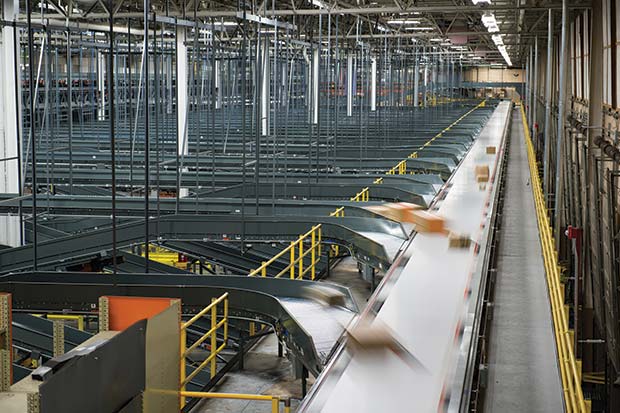The pandemic has accelerated the rate of change across the supply chain – from big warehouse operations through to microfulfilment, the latest technology is helping hard-pressed operators stay competitive, explains Ronald Binkofski, Vice President and General Manager of Honeywell Intelligrated Europe.
 Some of the links in the supply chain have been irrevocably weakened by the pandemic while others were already suffering fundamental issues before COVID-19. Social distancing, on-going staff shortages, rising labour rates and an aging workforce have all stressed conventional distribution networks. However, the single biggest game-changer, spurred on by responses to the virus, has been an across-the-board switch to online retail and home deliveries. Everything from the weekly shop to home luxuries are now being delivered to the door.
Some of the links in the supply chain have been irrevocably weakened by the pandemic while others were already suffering fundamental issues before COVID-19. Social distancing, on-going staff shortages, rising labour rates and an aging workforce have all stressed conventional distribution networks. However, the single biggest game-changer, spurred on by responses to the virus, has been an across-the-board switch to online retail and home deliveries. Everything from the weekly shop to home luxuries are now being delivered to the door.
As a result, established supply chain models, with a focus on traditional retail, are proving increasingly inefficient at coping with the combined impact of all these factors. Fortunately, there are answers to these problems: enhanced warehouse automation and microfulfilment. Understanding how to implement them can be an issue, especially for customers with demanding and complex requirements, such as e-commerce platforms, freight handling at airports and post and parcel operators.
A comprehensive warehouse solution
Many of the technologies required to effectively automate a warehouse already exist or are starting to come to market but bringing them all together into a cohesive implementation entails dedicated sector specialisms and a detailed understanding of the user’s core needs. Creating a comprehensive warehousing solution requires far more than simply installing conveyors, sortation systems, specialist software controls, automated storage and next generation robotics; bringing them all together to deliver an easy-to-use and flexible system demands a range of specialist integrator skills.
Moreover, the final installation needs to be highly reliable as disruptions caused by unplanned downtime are extremely detrimental to bottom line performance and business reputation. Fortunately, applying data analytics can help overcome this problem by delivering the insights needed by plant engineers to implement predictive maintenance.
High speed sortation is in especially high demand within the e-commerce sector, where throughput speeds are increasing to meet the growth of online retail. But running equipment faster creates a problem – excessive noise pollution. This is an area where cutting-edge software controls come into play as they can help maximise throughput without necessarily increasing line speeds. The result: enhanced productivity without added equipment noise.
Keeping pace with change
The upward trend of e-commerce isn’t going to slow any time soon, according to analysts, which in turn is boosting the growth of omnichannel commerce, where distribution and a diverse range of retail platforms are seamlessly brought together by backend systems. This makes life easier for the purchaser, but it can complicate operations for the bigger warehouse operators. This is where microfulfilment is finding a role, filling the gaps left by larger operations, especially in the areas of click-and-collect and grocery retail home delivery.
Conventional distribution centres can stock a vast range of products, but they can be expensive to operate and can be a long distance from domestic and retail purchasers.
Microfulfilment can help address these issues by enabling retail outlets to incorporate fulfilment operations into their day-to-day operations. Orders can be completed closer to the customer – saving time, cutting last mile costs and reducing the need for long journeys, which in turn cuts emissions.
However, there can be drawbacks. In-store picking, the go-to method for grocery retailers, can have a negative impact on in-store shoppers. Shelves and display units can be emptied by pickers and there is also the risk of unnecessary in-store traffic, which can lead to unwelcome congestion. Retailers are therefore increasingly looking to move their picking operations out of their stores and into adjacent microfulfilment centres. As a result, microfulfilment is creating interesting opportunities for players in the warehouse automation market, but it’s not all about mechanical processes. Irrespective of the size of operation, there’s a universal constant – the workforce. Employee management software applications, which enable companies to much better utilise staff, are increasingly important as labour shortages can’t be resolved overnight. Leading edge systems can even offer insights into likely staff turnover rates using data analytics.
Maximising opportunities
Post-pandemic demand is running ahead of the recovery of the supply chain. The cost of labour is rising and its availability is falling – a problem amplified by the pandemic, which has put a brake on migration simply because people are less likely to travel for a job while there’s uncertainty about their ability to get back home. These factors are creating severe on-going difficulties across distribution networks of all sizes.
The good news is that system suppliers and integrators can help supply chain operators maximise opportunities by helping them overcome the current stumbling blocks. Next generation palletisation technology, smart robotics and fulfilment stations, all linked with the latest process management software, are already helping businesses prepare for the future; now’s the time to start talking to an industry expert to learn how you can benefit from the latest in warehouse technology.




Comments are closed.